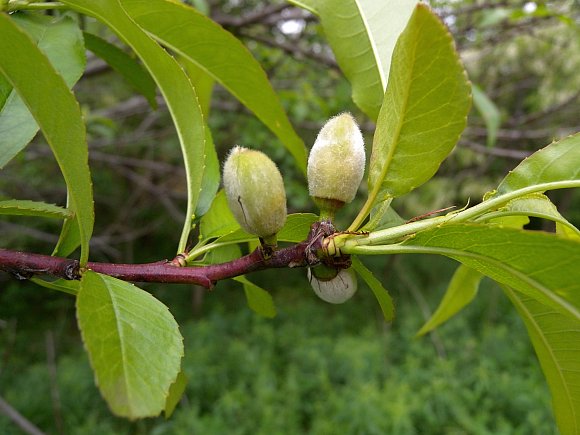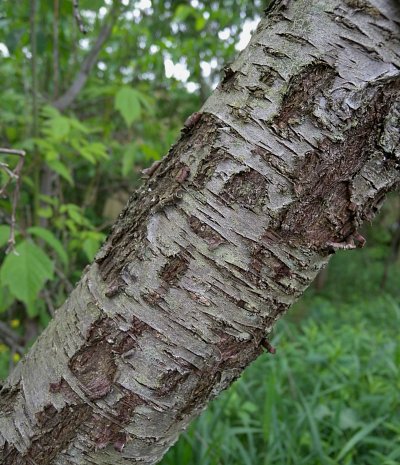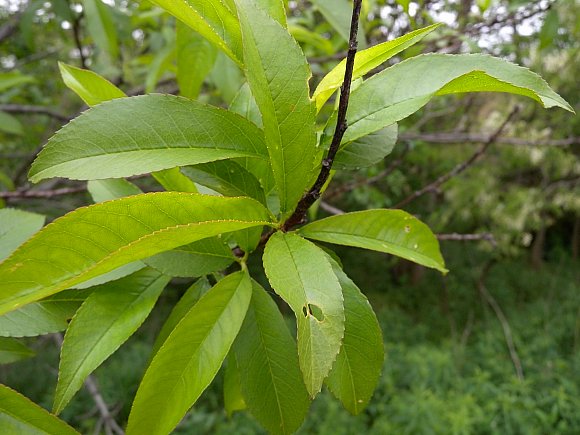
The blooming period occurs during mid-spring for about 2 weeks before the vernal leaves develop. The flowers have a pleasant fragrance. Afterwards, fertile flowers are replaced by fruits that become mature during the summer or fall. Initially, these fruits are relatively green, ovoid in shape, fuzzy from dense hairs, and small in size. At maturity, these fruits are up to 3" long and 3" across, yellow to deep orange-red, globoid or globoid-ovoid in shape, and still fuzzy from dense hairs (however, the dominance of a recessive gene can produce glabrous fruits that are called nectarines). The fruits of wild Peach trees tend to be smaller in size than those of cultivated trees. The juicy flesh of mature fruits is sweet to sweet-tart in flavor and either white or yellow. Mature fruits also produce a distinctive peach-like aroma. The drupes of these fruits are ½-¾" long, ovoid in shape, and slightly flattened; their surfaces are red to reddish brown and deeply pitted. The root system is woody, spreading, and relatively shallow.
Cultivation: This tree prefers full sun, well-drained moist conditions, and a fertile loamy soil. While it can tolerate partial shade, drier conditions, and less fertile soil, fewer and smaller fruits will be produced. Longevity of individual trees is typically 10-15 years; fruit can be produced as early as the third year. Peach is regarded as a relatively difficult tree to cultivate because it is vulnerable to various disease organisms and insects. One common disease, peach curl, can cause defoliation of trees. Peach is also intolerant of severe winter cold (temperatures below -10º F) and it is vulnerable to late spring frosts. These environmental problems can interfere with fruit set. Different cultivars of Peach vary in their resistance to these various problems.

Range & Habitat: Naturalized trees of Peach are relatively uncommon in Illinois, occurring in scattered counties across the state (see Distribution Map). However, such trees rarely persist in the environment and they are not invasive. Peach was introduced into North America from China as a fruit tree. It is still widely cultivated. Habitats include thickets, abandoned homestead sites, roadsides, and other disturbed habitats.
Faunal Associations: Bees are the most important pollinators of the flowers of Peach (Prunus persica); they are attracted to their nectar and pollen. These bee pollinators include leaf-cutting bees (Magachile spp.), mason bees (Osmia spp.), and Andrenid bees (Andrena spp.); see Discover Life (accessed 2015) and Krombein et al. (1979). Some insects feed destructively on Peach trees; they include leaf beetles, plant bugs, stink bugs, aphids, leafhoppers, armored scales, mealybugs, larvae of tiger moths (Arctiidae), larvae of owlet moths (Noctuidae), larvae of clear-winged moths (Sesiidae), and thrips (see the Insect Table for a more complete list of these species.

Among vertebrate animals, the Purple Finch feeds on the buds of Peach, and several mammals feed on this tree, including: the White-tailed Deer (foliage, twigs), Cottontail Rabbit (saplings), tree squirrels (fruits), Raccoon (fruits), and probably the Opossum (fruits). See the University of Missouri Extension (2021).
Photographic Location: A thicket in NW Ohio.
Comments: Peach trees have attractive flowers during the spring and their large fuzzy fruits can be delicious. It should be noted that the smooth fruits called 'nectarines' are from the same tree species as peaches. Peach can be distinguished from other similar trees by its large pink flowers (1" across or more), its distinctive fruits, and its long leaves that have a tendency to droop from their petioles and to fold upward along their central veins.